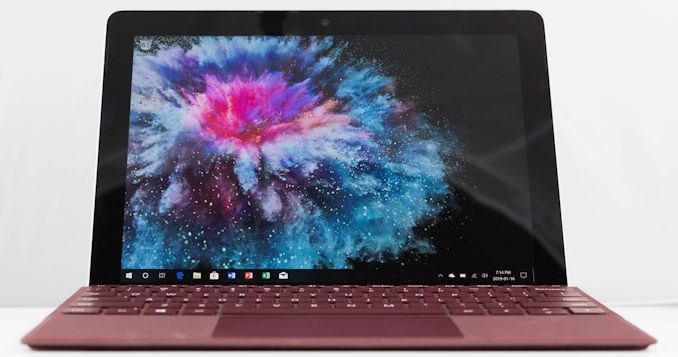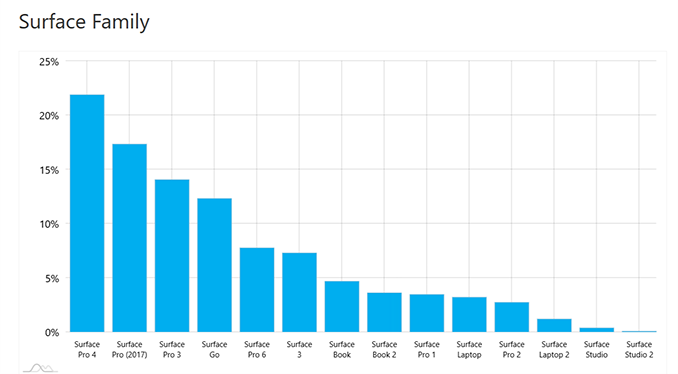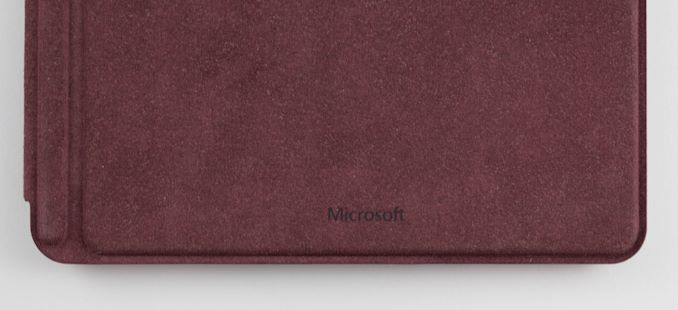The Microsoft Surface Go LTE Review: Unmatched Mobility
by Brett Howse on January 17, 2019 8:00 AM EST
Microsoft’s Surface Pro lineup has been a design win for the company for several years now. The Surface Go was launched in July of 2018 as a lower-cost version of the Surface Pro, offering buyers a less expensive way to become a Surface customer, and by the nature of its smaller size compared to the Surface Pro, an even more portable convertible Surface tablet. When the device was initially announced, a model with LTE connectivity was also in the works, and the Surface Go LTE arrived in November 2018.
Featuring a 10-inch display, the Surface Go is quite a bit smaller than the Pro, and the obvious comparison to make would be against the Surface 3, which launched way back in 2015. In the three year gap between these models, Microsoft had seemed to abandon the idea of the smaller convertible tablet in their lineup. But thanks to the smaller price tag, it was always a popular model, and it is great to see them reintroduce the reduced size Surface again. Even though the Surface 3 launched way back in 2015, it still has a usage share higher than any Surface launched outside of the Pro models, and now the Surface Go.

Source: AdDuplex.com
Looking at numbers from AdDuplex from December 2018, it makes it clear why the Surface Go was launched. And despite it only being on the market for about five months, it’s clearly gained a lot of traction in the Surface market, with usage share outstripping that of every other non-Pro model ever launched. We never got a chance to review the original Surface Go, but Microsoft has sent us the Surface Go LTE model for a full review.
The Surface Go LTE offers the benefit of always-on connectivity – assuming you have cellular coverage of course – and this opens it up to an even wider audience of customers. Microsoft is clearly aiming the Surface Go LTE at business customers looking for a small device they can take on-site, with an even smaller footprint than the Surface Pro LTE, and a lighter form factor. As has been the case with the last couple of LTE variants for Surface, the Surface Go LTE utilizes a Qualcomm X16 modem.
The rest of the Surface Go is unchanged. It’s still powered by the dual-core Intel Pentium 4415Y processor, and has the same 10-inch 1800x1200 3:2 PixelSense display. The only real difference is that the LTE variant is only available with 8 GB of RAM and 128 GB of SSD storage. The 4 GB / 64 GB eMMC model cannot be purchased with LTE.
| Microsoft Surface Go | |||||
| Surface Go Specifications | |||||
| CPU | Intel Pentium Gold 4415Y (Kaby Lake-Y) 2 core, 4 thread, 1.6 GHz base frequency |
||||
| GPU | Intel HD 615 24 EUs 850 MHz boost frequency |
||||
| Display | 10-inch PixelSense 1800x1200 3:2 aspect 216 Pixels Per Inch 10-point Multitouch Surface Pen support |
||||
| Dimensions | 245 x 175 x 8.3 mm 9.6 x 6.9 x 0.33 inches |
||||
| Weight | 522 grams (WiFi) / 532 grams (LTE) 1.15 lbs (WiFi) / 1.17 lbs (LTE) |
||||
| RAM | 4 or 8 GB LPDDR3-1866 | ||||
| Storage | 64 GB eMMC 128 NVMe SSD optional 256 GB NVMe SSD (Commerical Option) |
||||
| Wireless | 802.11ac with Bluetooth 4.1 Qualcomm Snapdragon X16 LTE Optional |
||||
| Battery | Up to 9 hours of video playback 24W Charger |
||||
| Cameras | Windows Hello IR camera 5 MP Front Camera with 1080p video 8 MP Rear Camera with 1080p video |
||||
| Ports | USB Type-C 3.1 Gen 1 with power delivery Surface Connect MicroSD Headset |
||||
| Price | 4GB/64GB $399 4GB/128GB $499 8GB/128GB $549 8GB/128 GB LTE $679 Windows 10 Pro $50 extra |
||||
The Surface Go offers many of the same features as its larger siblings, including the Surface Connect port for charging and data. This is a big upgrade over the Surface 3, which only offered micro USB charging, and the Surface Go ships with a 24-Watt AC adapter. The advantage for business customers here is that the Surface Go will work with the same Surface Dock as the rest of the lineup, meaning it can easily be connected to power, displays, and Ethernet on the desk, and then with one magnetic connector, becomes instantly portable.
The Surface Go also offers USB Type-C, which is a huge advantage for the Surface Go compared to the Surface Pro, since you can use any Type-C charger while on the road with the Surface Go. It does lose the USB Type-A port that is a key feature of the Surface Pro, but on a portable device like this, that is a worthwhile trade-off. If you need Type-A, you can of course get an adapter for Type-C, or use the Surface Dock.
It's been quite remarkable to see just how popular this device is in the market, despite it only being available for a few months. Let’s dig into the Surface Go LTE.











79 Comments
View All Comments
thewishy - Thursday, January 17, 2019 - link
I've had a non-lte 8/128gb since November. I have a work Dell XPS 15, which is hugely powerful but has shockingly bad battery life and is utterly unsuited to use on a plane - so I have another machine to do heavy lifting.This machine gets used on work trips where I don't need much more than an RDP client to a lab, work, excel and OWA, and I want something to entertain me on long flights and evenings if I feel like.
It works brilliantly on the tray table in economy, the battery life might be "Poor", but with a 99wh USB-PD power pack the endurance of 16-24hrs. Given the cost and ease with which the life can be extended, 6hrs of browsing / word and 8-9 hours of movies without the power bank is reasonable IMHO. I wouldn't want to make it heavier for the sake of enhanced endurance. USB-PD charger allows me to charge phone, laptop and power bank with a single charger.
Performance is... slow. It's very noticeably less snappy than anything else I use, but doesn't crawl to a halt under load (For example, no problems with it swapping out). Under light use it's fine, and it works fine for light games.
Screen is sharp, a mouse transforms usability for office use. Keyboard is ok after a short adjustment period, but the trackpad can get in the way occasionally.
Bezel is a little large, but does make it easy to hand hold.
Lack of USB-A is a bit of a pain if you have a Yubikey, and a second USB-C would be lovely if you're using that for charging.
As my only machine it would drive me nuts, but for a specific use case it's been perfect.
TheinsanegamerN - Saturday, January 19, 2019 - link
The interior design of the Go is pathetic for battery packaging. You wouldnt have to make it thicker to fit more battery in there.Trefugl - Thursday, January 17, 2019 - link
Any idea how the CPU performance compares to the original Surface Pro (16:9 one)? I have one of those that I still use for travel, but it's definitely showing its age and the pen input isn't nearly as good as modern surface tablets, and the screens are nearly as nice either... Ideally I'm hoping that I could do some light editing of raw photos in lightroom while on the go, even if it's mildly painful... still better than trying to do it on my phone or carrying around something much bigger.Brett Howse - Thursday, January 17, 2019 - link
Hi Trefugl. I'll reference you to our Online Bench which was also linked in the article:https://www.anandtech.com/bench/product/1207?vs=23...
HStewart - Saturday, January 19, 2019 - link
I also have original Surface Pro and rarely use it - even though it performance is around i7 Y CPU.A good link to compare cpus is the following
https://cpu.userbenchmark.com/Compare/Intel-Pentiu...
It going to be really interesting to see Lakefield - it will like beat the Surface Pro 1 cpu in performance and have extreme battery life - this will be perfect for LTE companion
HStewart - Saturday, January 19, 2019 - link
Computer performance changes over time - I did use my Surface Pro 1 for photoshop and even Lightwave - but new CPU's today make a big difference.eastcoast_pete - Thursday, January 17, 2019 - link
Interesting device, somewhat overpriced. I really wish MS would go further on the mobility aspect and provide a significantly (50% bigger) larger battery. Even with 100 g more weight, it would still be light enough to carry around. Always connected shouldn't mean being plugged into an outlet after just a few hours.tmanini - Thursday, January 17, 2019 - link
"Microsoft also color calibrates all of its displays"I didn't find a handy reference article for this, so I can't confirm the statement or what exactly is done. But even if they do 'something' before it is boxed up, that calibration will drift in short order and essentially become useless. (if you plan to rely on it)
melgross - Thursday, January 17, 2019 - link
That’s not true. It used to be true in the days of the crt, but not now. Apple also calibrates all of its displays, including those in the iMac, and it’s pretty stable. That doesn’t mean that several years later it’s still perfect, but it’s pretty close, even then.The thing about these though, is that they’re just sRGB, which isn’t saying much these days.
anactoraaron - Thursday, January 17, 2019 - link
Exactly this. What exactly is the point of having a calibrated accurate display for maybe 1 month? Panels drift the most in the first year.The other thing that happens not just here at AT is these notebooks and tablets being touted as 'for image and video professionals' just because the display is accurate out of the box. This needs to stop.
Any system that lacks a display osd/hardware rgb channel/brightness/contrast adjustment isn't suited for any professional. Software can only do so much (making adjustments through Intel graphics software is awful) and for folks that absolutely need color accuracy (longer than 1 month out of the box) need the ability to adjust color channels, brightness, and contrast at the hardware level. I had a surface pro, and over time software couldn't properly calibrate it anymore. Sold it recently and went back to desktop, mobility be damned.